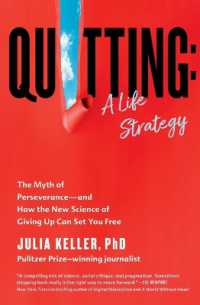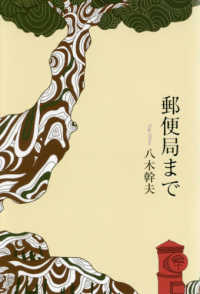- ホーム
- > 洋書
- > 英文書
- > History / American
Full Description
This edition of our classic text draws on analysis of new material released from archives in Moscow, Beijing, Hanoi, and other capitals of communist-bloc nations - helping to develop a truly international history of the Cold War, a complex and dynamic conflict that lasted more than forty years and continues to shape the foreign policy of the United States and other nations. Another important recent trend considered is the intensive study of the role of ideology in influencing policy on both sides of the conflict. Dr. Levering holds that the liberal internationalism espoused by leading Democrats and Republicans during World War II, most Americans' profound dislike of communism and communists, contributed greatly to America's decision to oppose postwar Soviet foreign policy. Many recent studies of the Cold War emphasize the role of Marxist-Leninist ideology in postwar Soviet and Chinese foreign policy. Although these new directions in scholarship are important, the basic emphases of the original edition remains the same - U.S. actions and public opinion and relations between the two leading actors in the Cold War, the United States and the Soviet Union.
Enhanced as well is coverage of the two large-scale but limited wars that grew out of the conflict, the Korean War and the Vietnam War, and of the most dangerous confrontation of the nuclear age thus far, the Cuban missile crisis.
Contents
Foreword / VII Preface / XI Prologue: Uneasy Allies, 1941-1945 / 1 Chapter One: Downward Spiral During the Truman-Stalin Years, 1945-1953 / 14 The Cold War Begins, 1945-1946 / 14 Containment and Countercontainment, 1947-1949 / 25 The Most Dangerous Phase, 1950-1952 / 33 Conclusion / 45 Chapter Two: The Institutionalized Cold War, 1953-1962 / 47 The Cold War at Home / 50 A Modest Improvement in East-West Relations, 1953-1955 / 57 The Second Dangerous Phase, 1956-1962 / 65 Conclusion / 88 Chapter Three: The Shift Toward Relative Detente, 1963-1972 / 91 An Improved Atmosphere in 1963 / 93 Vietnam at Center Stage, 1964-1968 / 98 Toward a New Balance of Power, 1969-1972 / 109 Conclusion / 124 Chapter Four: The Roller-Coaster Years, 1973-1984 / 126 Detente Bogs Down, 1973-1976 / 128 Carter Rides the Roller Coaster, 1977-1979 / 144 The Third Dangerous Phase, 1980-1984 / 153 Conclusion / 170 Epilogue: The Cold War Ends, 1985-1991 / 172 Bibliographical Essay / 181 Index / 199 Photo Essay: The Cold War at Midpassage, 1957-1973 / follows page 90 Maps / 41, 69, 101, 148, 167







